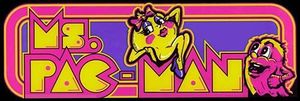When Pac-Man was still hot in the arcades, a small company known as GCC, or General Computer Corp., was in the business of making arcade "enhancements" which were essentially small hacks designed to make certain games more appealing. GCC was known for an add on that they had sold for Atari's Missile Command when they sat down to design a hack for Pac-Man. They surprised themselves with the quality of their hack, which they had entitled "Crazy Otto", and pitched their idea to Midway Games.
Midway was hungry to cash in on the Pac-Man phenomenon that was occurring at the time, and Namco's own sequel to Pac-Man, Super Pac-Man (which was the first game from the company to use a Motorola M6809 microprocessor), was still a few months out of development, so they bought the rights to "Crazy Otto", and renamed it Ms. Pac-Man in an effort to entice more females to play arcade games. Namco was not pleased with Midway's alteration of Pac-Man into a new game. As a result, a deal was struck between the two companies that would hand the rights of Ms. Pac-Man back over to Namco after a number of years. Ms. Pac-Man was not quite as acknowledged by Namco in Japan until very recently when it seems, in perhaps a nod to the newer game's popularity and quality, it began appearing in select Namco Museum compilations, for the Sony PlayStation.
Ms. Pac-Man expands on the original Pac-Man, in the following ways. Instead of one static blue-on-black maze, there are now four multi-colored mazes to complete. Instead of a bonus appearing stationary below the ghost regenerator, it now bounces in through a tunnel, takes a few laps around the regenerator, and eventually bounces back out through another tunnel if not eaten. Instead of just one escape tunnel, there are (in all but one of the mazes) two sets of tunnels. And lastly, Ms. Pac-Man introduces an element of randomness to the ghost behavior which eliminated the effectiveness of patterns that crippled the earning power of the original Pac-Man, and made Ms. Pac-Man more of a game of skill, than memorization. The same is said for Jr. Pac-Man.
Ms. Pac-Man was considerably faster than Pac-Man as well, but some players felt that it wasn't fast enough. Hackers began to offer unofficial EPROM upgrades that sped the game up. Most of these mods sped up Ms. Pac-Man herself, but not the ghosts, which made the game easier and more attractive to novice players. (The original game also had speedup hack on dip switch).
As with the original Pac-Man, there really is no story element per se, but the intermissions that you are treated to tell the story of how Pac-Man and Ms. Pac-Man meet while being chased, fall in love, and have a child together (dropped off by a passing stork).
Table of Contents
Gameplay summary
- The player must direct Ms. Pac-Man around each of the game's four new mazes by using the four-directional joystick (as in the original Pac-Man).
- You must eat every regular pellet and power pellet to advance to the next round. Once you have done so, the walls will flash, regardless of color.
- You must avoid contact with the ghosts while they are their normal color. If they catch you, Ms. Pac-Man will lose a life, and must restart at centre.
- If you eat a power pellet, the ghosts will turn blue, and you will have the chance to eat them for bonus points until they return to their normal color.
- As in the original Pac-Man, the ghosts will be forced to travel at half their normal speed, through the side escape tunnels. Use them to get away.
- A bonus item will enter the maze from one of the escape tunnels twice per round and bounce around it randomly. Eat the item for bonus points.
- Pac-Man
- Super Pac-Man
- Pac & Pal
- Pac-Mania
- Pac-Man Arrangement
- Pac-Man VR
- Pac-Man: Adventures in Time
- Ms. Pac-Man: Quest for the Golden Maze
- Ms. Pac-Man for Prizes
- Pac-Man Arrangement (2005)
- Pac-Pix
- Pac'n Roll
- Pac-Man + Tournaments
- Pac-Man Chomp Mania
- Pac-Man 256
- Pac-Man Hats
- Pac-Man Hats 2
- Pac-Man Maker
- Pac-Man: Ralph Breaks the Maze
- Athletic VR Pac-Man Challenge
- Pac-Man Geo
- Pac-Man Championship Edition
- Pac-Man Championship Edition 2
- Pac-Attack
- Pac-Slot
- Pac-Eight
- Pac-Carnival
- Pac'n Party
- Pac-Man Casino Card Game Pack
- Pac-Man Casino Slots Pack
- Pac-Man Puzzle
- Pac-Match
- Pac-Man Bowling
- Pac-Man Pinball
- Pac-Man Pinball Advance
- Space Invaders vs. Pac-Man
- Pac-Man World Rally
- Pac-Motos
- Pac-Man Pizza Parlor
- Pac-Man Reborn
- Pac-Match Party
- Pac-Chain
- Pac-Man Kart Rally
- Pac'n Jump
- Pac-Man = 10
- Pac-Chomp
- Pac-Man Dash
- Pac-Man Monsters
- Pac-Man Friends
- Pac-Man Bounce: Puzzle Adventure
- Pac-Man Puzzle Tour
- Pac-Man Pop
- Ms. Pac-Man and Galaga: Class of 1981
- Pac-Man Collection
- Pac-Man Three Pack
- R: Racing Evolution with Pac-Man Vs.
- Pac-Man Vs. / Pac-Man World 2
- Pac-Man: 25th Anniversary
- Ms. Pac-Man: Maze Madness / Pac-Man World
- Pac-Man Power Pack
- Namco All-Stars: Pac-Man and Dig Dug
- Pac-Man Arcade Party
- Pac-Man Presents: Namco Games
- Pac-Man World 3 / Namco Museum DS
- Pac-Man Museum
- Pac-Man Pixel Bash
- Namco Museum Arcade Pac
- Pac-Man Museum+

